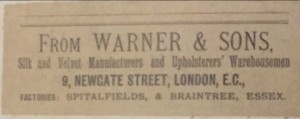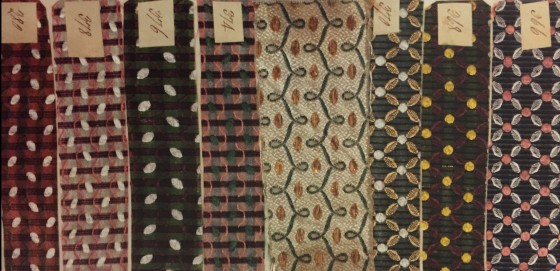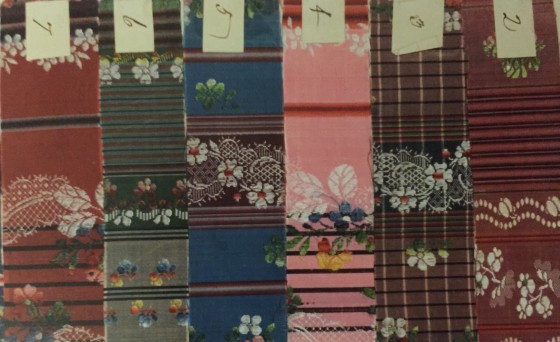by Lesley Ellis Miller
V&A Publishing, 2014
In 1972, Warner & Sons sold a selection of items from its business archive through Christie’s, and donated a special collection to the Victoria & Albert Museum in London. Selected by Nathalie Rothstein, among the pieces in the auction was a book dated 1760, and filled with beautiful, hand-woven dress silk samples.

In this small, unassuming document was the story of an item confiscated by British Customs in 1764, from French agents who were attempting to sell silks illegally in London. Nathalie Rothstein, textiles curator at the V&A, spent 20 years following the purchase in 1972, researching the individual textiles and their construction.
The exact movements of the book between 1764 and the time it was acquired by Warner & Sons are unclear, but at the Warner Textile Archive we are aware that it was in the possession of a silk weaving firm owned by William and Charles Beckwith, who were based in Coggeshall, Essex. The Beckwiths were extremely active in this area (around 1815) and also had an office in Chapel Yard, London. Employing many silk weavers from Spitalfields and Bethnal Green, it was an outwardly successful company, until, in 1835, William and Charles Beckwith declared themselves bankrupt, causing great sadness among this small, tight-knit Essex community.
We believe that the silk merchant’s book changed hands during the course of the closure of the Beckwith’s company, and was acquired by Daniel Walters, at this time working from New Mills in Braintree. When Warner & Sons purchased Daniel Walters in 1895, the book finally found its commercial use; the Warner family held it closely and these delicate and colourful samples provided inspiration for several of Warner & Sons’ designs in the late 19th and early 20th century.
Alongside a full reproduction of the book, in Selling Silks, Lesley Miller demonstrates the important role this silk sample book played in the European silk weaving centre of Lyon, and the influence of these designs on the Spitalfields tradition. Photographs of wonderfully-lavish fabrics decorate each page of this book, published by the V&A earlier this year, demonstrating the great skills of the hand weaver and the intricate patterns and techniques that could be created, even before the invention of the Jacquard loom. Many of the original colours have survived and demonstrate the wealth of creativity and style of this period.
Miller provides just enough of an explanation to inform and inspire the reader. The sample book reveals a clear and fascinating story of the times, and is illustrated with glorious painted portraits to demonstrate how dress silks from the sample book would have been worn by the upper classes.
A detailed glossary is extremely helpful and reflects the quality of the technical analysis of the fabric samples.
Silk samples from this period are held in the Warner Textile Archive Collection, and will be displayed via our online gallery during 2015.
As Archivist at the Warner Textile Archive it is incredibly moving to finally be able to see one of the most important textile pattern books, in print, not only in terms of the history of Warner & Sons, but for the history of the nation. This wonderful publication by Lesley Miller is an invaluable resource for historians, collectors and designers alike, and I am sure will continue to be so for decades to come.
Copies of ‘Selling Silks’ are available to purchase from the Warner Textile Archive Shop, costing £35.00. Our Shop is open every Wednesday 10am to 4pm, and on the first Saturday of the month. Alternatively, please telephone 01376 557741 and we’ll happily take an order for your copy.
